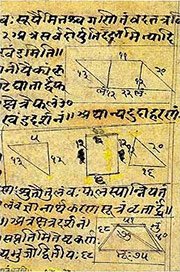Mahi, Mahī: 30 definitions
Introduction:
Mahi means something in Buddhism, Pali, Hinduism, Sanskrit, the history of ancient India, Marathi, Jainism, Prakrit, Hindi. If you want to know the exact meaning, history, etymology or English translation of this term then check out the descriptions on this page. Add your comment or reference to a book if you want to contribute to this summary article.
In Hinduism
Purana and Itihasa (epic history)
Source: Cologne Digital Sanskrit Dictionaries: The Purana Index1a) Mahī (मही).—A river in Kuśadvīpa.*
- * Brahmāṇḍa-purāṇa II. 19. 62; Matsya-purāṇa 163. 64; Viṣṇu-purāṇa II. 4. 43.
1b) Mādhavī, (Vasundharā);1 rescued by the Lord in Vārāha disguise from Pātāla; earth addressed the Lord in words of praise of his greatness;2 addressed by Sananda and other sages; the earth was rescued with mountains; and was divided into seven islands and created the four; bhū and other worlds;3 see Bhūmī.4
1c) With Vikeśī: a sthāna of Rudra;1 his son was Lohitānga.2

The Purana (पुराण, purāṇas) refers to Sanskrit literature preserving ancient India’s vast cultural history, including historical legends, religious ceremonies, various arts and sciences. The eighteen mahapuranas total over 400,000 shlokas (metrical couplets) and date to at least several centuries BCE.
Kavya (poetry)
Source: Shodhganga: The Kavyamimamsa of RajasekharaMahī (मही) is the name a locality mentioned in Rājaśekhara’s 10th-century Kāvyamīmāṃsā.—The river Mahī which is springs in Mālavā region and fall into the gulf of Combay.
Source: Brill: Śaivism and the Tantric Traditions (kavya)Mahī (मही) refers to the “earth”, according to Kālidāsa’s Raghuvaṃśa verse 9.78.—Accordingly: “Therefore, although the sun may fall to earth (mahī), or Himālaya lose its fixity, I’ll not return home like a common man, whose senses yearn for sensual things, and who has not perceived the truth”.

Kavya (काव्य, kavya) refers to Sanskrit poetry, a popular ancient Indian tradition of literature. There have been many Sanskrit poets over the ages, hailing from ancient India and beyond. This topic includes mahakavya, or ‘epic poetry’ and natya, or ‘dramatic poetry’.
Natyashastra (theatrics and dramaturgy)
Source: Wisdom Library: Nāṭya-śāstraMahī (मही) is the name of a meter belonging to the Anuṣṭubh class of Dhruvā (songs) described in the Nāṭyaśāstra chapter 32:—“the metre which has in its feet of eight syllables sixth and eighth long, is mahī”.

Natyashastra (नाट्यशास्त्र, nāṭyaśāstra) refers to both the ancient Indian tradition (shastra) of performing arts, (natya—theatrics, drama, dance, music), as well as the name of a Sanskrit work dealing with these subjects. It also teaches the rules for composing Dramatic plays (nataka), construction and performance of Theater, and Poetic works (kavya).
Jyotisha (astronomy and astrology)
Source: Wisdom Library: Brihat Samhita by VarahamihiraMahī (मही) is the name of a River, according to the Bṛhatsaṃhitā (chapter 16) (“On the planets—graha-bhaktiyoga”), an encyclopedic Sanskrit work written by Varāhamihira mainly focusing on the science of ancient Indian astronomy astronomy (Jyotiṣa).—Accordingly, “Saturn presides over the countries of Ānarta, Arbuda, Puṣkara, Saurāṣṭra, Abhīra, Śūdra, Raivataka, countries through which the river Sarasvatī passes as an underground stream and the western countries; over the natives of Kurukṣetra, the town of Somanātha, and persons born on the banks of the Vidiśā, the Vedasmṛti and the Mahī; over wicked men, uncleanly men and men of the lowest class; over oil-mongers, weak men and persons not possessing virility”.
Source: Wikibooks (hi): Sanskrit Technical TermsMahī (मही).—1. Base of a triangle. 2. Earth. Note: Mahī is a Sanskrit technical term used in ancient Indian sciences such as Astronomy, Mathematics and Geometry.

Jyotisha (ज्योतिष, jyotiṣa or jyotish) refers to ‘astronomy’ or “Vedic astrology” and represents the fifth of the six Vedangas (additional sciences to be studied along with the Vedas). Jyotisha concerns itself with the study and prediction of the movements of celestial bodies, in order to calculate the auspicious time for rituals and ceremonies.
Ayurveda (science of life)
Nighantu (Synonyms and Characteristics of Drugs and technical terms)
Source: Wisdom Library: Raj NighantuMahi (महि) or Mahī refers to “earth” and is mentioned in a list of 53 synonyms for dharaṇi (“earth”), according to the second chapter (dharaṇyādi-varga) of the 13th-century Raj Nighantu or Rājanighaṇṭu (an Ayurvedic encyclopedia). The Dharaṇyādi-varga covers the lands, soil [viz., Mahi], mountains, jungles and vegetation’s relations between trees and plants and substances, with their various kinds.

Āyurveda (आयुर्वेद, ayurveda) is a branch of Indian science dealing with medicine, herbalism, taxology, anatomy, surgery, alchemy and related topics. Traditional practice of Āyurveda in ancient India dates back to at least the first millenium BC. Literature is commonly written in Sanskrit using various poetic metres.
Shaktism (Shakta philosophy)
Source: Google Books: ManthanabhairavatantramMahī (मही) refers to the “surface of the earth”, according to the Manthānabhairavatantra, a vast sprawling work that belongs to a corpus of Tantric texts concerned with the worship of the goddess Kubjikā.—Accordingly, “May they, whom I have recollected and are satisfied, accept the vessel of the bali. [...] O god, the bali has been offered to the Yoginīs in the congregation of (Bhairava’s) host of the eight sacred seats beginning with Oṃkāra and in the secondary seats and to those born of the sacred fields and in the secondary fields and, O lord of the gods, in the gatherings (that take place) in the primary and secondary doors on the surface of the earth and underground in the Egg of Brahmā [i.e., mahī-pātāla-brahmāṇḍa], and within all the other places”.

Shakta (शाक्त, śākta) or Shaktism (śāktism) represents a tradition of Hinduism where the Goddess (Devi) is revered and worshipped. Shakta literature includes a range of scriptures, including various Agamas and Tantras, although its roots may be traced back to the Vedas.
Ganitashastra (Mathematics and Algebra)
Source: archive.org: Hindu MathematicsMahī (मही) represents the number 1 (one) in the “word-numeral system” (bhūtasaṃkhyā), which was used in Sanskrit texts dealing with astronomy, mathematics, metrics, as well as in the dates of inscriptions and manuscripts in ancient Indian literature.—A system of expressing numbers by means of words arranged as in the place-value notation was developed and perfected in India in the early centuries of the Christian era. In this system the numerals [e.g., 1—mahī] are expressed by names of things, beings or concepts, which, naturally or in accordance with the teaching of the Śāstras, connote numbers.

Ganitashastra (शिल्पशास्त्र, gaṇitaśāstra) refers to the ancient Indian science of mathematics, algebra, number theory, arithmetic, etc. Closely allied with astronomy, both were commonly taught and studied in universities, even since the 1st millennium BCE. Ganita-shastra also includes ritualistic math-books such as the Shulba-sutras.
In Buddhism
Theravada (major branch of Buddhism)
Source: Pali Kanon: Pali Proper Names1. Mahi. One of the five great rivers of India, all of which have a common origin (Vin.ii.237; A.iv.101; v. 22; S.ii.135; v. 38; Mil. 20, 104; Vsm.10, etc.). Anguttarapa was to the north of the Mahi (SNA.ii.437ff). It is also called Mahamahi.
2. Mahi. A Lankagiri, an officer of Parakkamabahu I., stationed at Assamandala tittha. Cv.lxxii.27.
Theravāda is a major branch of Buddhism having the the Pali canon (tipitaka) as their canonical literature, which includes the vinaya-pitaka (monastic rules), the sutta-pitaka (Buddhist sermons) and the abhidhamma-pitaka (philosophy and psychology).
Mahayana (major branch of Buddhism)
Source: Wisdom Library: Maha Prajnaparamita SastraMahī (मही) is the name of a river mentioned by the Buddha while teaching the practice of disgust, as mentioned in the Tiṃsamattā-sutta (or Lohita-sūtra), according to Mahāprajñāpāramitāśāstra chapter XLIII.—Accordingly, “thus forty Bhikṣus from the land of Po-li (“inhabitant of the region of Pāvā”; Pāvā or Pāpā is the actual Kasia) who observed fully the twelve pure practices (dhūtaguṇa) came to the Buddha who taught them the practice of disgust (nirveda, saṃvega). The Buddha asked them: The five rivers, Heng-k’ie (Gaṅgā), Lan-meou-na (Yamunā), Sa-lo-yeou (Sarayū), A-tche-lo-p’o-t’i (Aciravati) and Mo-hi (Mahī) arise and empty into the great ocean (mahāsamudra). Is the mass of water contained in this ocean great or small? The Bhikṣus answered: It is very great. The Buddha continued: In the course of a single kalpa, during his animal existences, a single man has been cut up and flayed. In yet other circumstances when he committed a wrong-doing, his hands and feet have been cut off and his head has been has been cut off. Well then! His blood (lohita) that has been spilled surpasses the amount of water in the ocean”.

Mahayana (महायान, mahāyāna) is a major branch of Buddhism focusing on the path of a Bodhisattva (spiritual aspirants/ enlightened beings). Extant literature is vast and primarely composed in the Sanskrit language. There are many sūtras of which some of the earliest are the various Prajñāpāramitā sūtras.
India history and geography
Source: Ancient Buddhist Texts: Geography of Early BuddhismMahī (मही) is the name of a river situated in Majjhimadesa (Middle Country) of ancient India, as recorded in the Pāli Buddhist texts (detailing the geography of ancient India as it was known in to Early Buddhism).—Mahī, one of the five great rivers mentioned in Pāli literature. The river Mahī is a tributary of the Gaṇḍaka.
Source: Cologne Digital Sanskrit Dictionaries: Indian Epigraphical GlossaryMahī.—(IE 7-1-2), ‘one’. Note: mahī is defined in the “Indian epigraphical glossary” as it can be found on ancient inscriptions commonly written in Sanskrit, Prakrit or Dravidian languages.

The history of India traces the identification of countries, villages, towns and other regions of India, as well as mythology, zoology, royal dynasties, rulers, tribes, local festivities and traditions and regional languages. Ancient India enjoyed religious freedom and encourages the path of Dharma, a concept common to Buddhism, Hinduism, and Jainism.
Languages of India and abroad
Pali-English dictionary
Source: BuddhaSasana: Concise Pali-English Dictionarymahi : (aor. of mahati) honoured; revered. || mahī (f.) the earth; name of a river.
Source: Sutta: The Pali Text Society's Pali-English DictionaryMahī, (f.) (f. of mah, base of mahant, Vedic mahī) the earth (lit. Great One) Mhvs 5, 266; Sdhp. 424, 472; Loc. mahiyā Miln. 128; mahiyaṃ DhsA. 62.—Note. As mahī is only found in very late P. literature, it must have been re-introduced from Sk. sources, and is note a direct correspondent of Vedic mahī.

Pali is the language of the Tipiṭaka, which is the sacred canon of Theravāda Buddhism and contains much of the Buddha’s speech. Closeley related to Sanskrit, both languages are used interchangeably between religions.
Marathi-English dictionary
Source: DDSA: The Molesworth Marathi and English Dictionarymahī (मही).—f (S) The earth. 2 The river Mahi or Mhye.
--- OR ---
māhī (माही).—m f (māgha S) The month commonly called māgha, January-February.
Source: DDSA: The Aryabhusan school dictionary, Marathi-Englishmahī (मही).—f The earth.
Marathi is an Indo-European language having over 70 million native speakers people in (predominantly) Maharashtra India. Marathi, like many other Indo-Aryan languages, evolved from early forms of Prakrit, which itself is a subset of Sanskrit, one of the most ancient languages of the world.
Sanskrit dictionary
Source: DDSA: The practical Sanskrit-English dictionaryMahi (महि).—m., n. Greatness; सर्वात्मना महि गृणामि यथामनीषम् (sarvātmanā mahi gṛṇāmi yathāmanīṣam) Bhāgavata 7.9.12. -m. Intellect. -f. = मही (mahī) The earth. -ind. Greatly, very much.
--- OR ---
Mahī (मही).—1 Earth; as in महीपाल, महीमृत् (mahīpāla, mahīmṛt) &c.; मही रम्या शय्या (mahī ramyā śayyā) Bhartṛhari 3.79.
2) Ground, soil; चेरतुः संयुगमहीं सासारौ जलदाविव (ceratuḥ saṃyugamahīṃ sāsārau jaladāviva) Rām.6.17.34.
3) Landed property or estate, land.
4) A country, kingdom.
5) Name of a river falling into the gulf of Cambay.
6) (In geom.) The base of any plane figure.
7) A large army (Ved).
8) A cow; ŚB. on MS.1.3.49.
9) Earth (as a substance, stones, bricks &c); Manusmṛti 7.7.
1) Space.
Source: Cologne Digital Sanskrit Dictionaries: Edgerton Buddhist Hybrid Sanskrit DictionaryMahī (मही).—(= Sanskrit maha), festival, in jātī-mahī saṃvṛttā Divyāvadāna 515.18; in same line, jātamahaṃ kṛtvā; both birth- festival; is the otherwise unrecorded -mahī adapted to the gender of jātī-? Cf. jāti-maha.
Source: Cologne Digital Sanskrit Dictionaries: Shabda-Sagara Sanskrit-English DictionaryMahi (महि).—f.
(-hiḥ) The earth. E. mah to worship, aff. in; more commonly mahī q. v.
--- OR ---
Mahī (मही).—f. (-hī) 1. The earth. 2. A river, the Mahi which rises in the province of Malwa, and after pursuing a westerly course of about 280 miles, falls into the upper part of the gulf of Cambay. 3. A cow. 4. A potherb, (Hingtsha repens.) 5. The base of a plain figure, (in geometry.) E. mah to worship or be worshipped, aff. i, and ṅīṣ added; also without the addition mahi .
Source: Cologne Digital Sanskrit Dictionaries: Benfey Sanskrit-English DictionaryMahi (महि).—[mah + i], ved. adj. Great.
--- OR ---
Mahī (मही).—see maha.
Source: Cologne Digital Sanskrit Dictionaries: Cappeller Sanskrit-English DictionaryMahi (महि).—adj. (only °— & [nominative] [accusative] sgl.) great; [adverb] greatly, much.
--- OR ---
Mahī (मही).—v. 2 mah.
Source: Cologne Digital Sanskrit Dictionaries: Monier-Williams Sanskrit-English Dictionary1) Mahī (मही):—[from mah] a f. See mahī, p. 803, col. 2.
2) Mahi (महि):—[from mah] 1. mahi mfn. (only [nominative case] [accusative] sg. n.) = mahat, great, [Ṛg-veda; Atharva-veda; Vājasaneyi-saṃhitā]
3) [v.s. ...] ind. greatly, very, exceedingly, much, [ib.; Śāṅkhāyana-śrauta-sūtra]
4) [v.s. ...] m. n. greatness, [Bhāgavata-purāṇa]
5) [v.s. ...] m. = mahat, intellect, [ib.]
6) [v.s. ...] f. = mahī1 the earth, [cf. Lexicographers, esp. such as amarasiṃha, halāyudha, hemacandra, etc.] (in [compound] not always separable from 1. mahin q.v.)
7) [from mah] 2. mahi in [compound] for mahī.
8) [from mah] 3. mahi in [compound] for 2. mahin.
9) Mahī (मही):—[from mah] 1. mahī f. (cf. 2. mah), ‘the great world’, the earth (cf. urvī, pṛthivī), [Ṛg-veda] etc. etc. (in later language also = ground, soil, land, country)
10) [v.s. ...] earth (as a substance), [Manu-smṛti vii, 70]
11) [v.s. ...] the base of a triangle or other plane figure, [Colebrooke]
12) [v.s. ...] space, [Ṛg-veda iii, 56, 2; v, 44, 6 etc.]
13) [v.s. ...] a host, army, [ib. iii, 1, 12; vii, 93, 5 etc.]
14) [v.s. ...] a cow, [Ṛg-veda; Vājasaneyi-saṃhitā] ([Naighaṇṭuka, commented on by Yāska ii, 11])
15) [v.s. ...] [dual number] heaven and earth, [Ṛg-veda i, 80, 11; 159, 1 etc.] ([Naighaṇṭuka, commented on by Yāska iii, 30])
16) [v.s. ...] [plural] waters, streams, [Ṛg-veda ii.11, 2;v, 45, 3etc.]
17) [v.s. ...] Hingtsha Repens, [cf. Lexicographers, esp. such as amarasiṃha, halāyudha, hemacandra, etc.]
18) [v.s. ...] a kind of metre, [Colebrooke]
19) [v.s. ...] Name of a divine being (associated with Iḍā and Sarasvatī, [Ṛg-veda i, 13, 9; Sāyaṇa]; cf. [Naighaṇṭuka, commented on by Yāska i, 11])
20) [v.s. ...] of a river, [Mahābhārata; Harivaṃśa]
21) [v.s. ...] of the number ‘one’ [Gaṇitādhyāya]
22) [from mah] 2. mahī in [compound] for maha.
23) Mahi (महि):—a mahi-keru etc. See p. 802, col. 3.
24) Mahī (मही):—b mahī-kampa etc. See p. 803, col. 2.
Source: Cologne Digital Sanskrit Dictionaries: Yates Sanskrit-English Dictionary1) Mahi (महि):—(hiḥ) 2. f. The earth.
2) Mahī (मही):—(hī) 3. f. The earth; a river; a cow; a potherb.
Source: DDSA: Paia-sadda-mahannavo; a comprehensive Prakrit Hindi dictionary (S)Mahī (मही) in the Sanskrit language is related to the Prakrit word: Mahī.
[Sanskrit to German]
Sanskrit, also spelled संस्कृतम् (saṃskṛtam), is an ancient language of India commonly seen as the grandmother of the Indo-European language family (even English!). Closely allied with Prakrit and Pali, Sanskrit is more exhaustive in both grammar and terms and has the most extensive collection of literature in the world, greatly surpassing its sister-languages Greek and Latin.
Hindi dictionary
Source: DDSA: A practical Hindi-English dictionary1) Mahi (महि):—(nf) the earth; ~[dhara] a mountain, hill.
2) Mahī (मही):—(nf) the earth; soil; buttermilk; ~[dhara] a mountain; hill; ~[pa/pati] a king.
3) Māhī (माही):—(nf) a fish.
...
Prakrit-English dictionary
Source: DDSA: Paia-sadda-mahannavo; a comprehensive Prakrit Hindi dictionary1) Mahī (मही) in the Prakrit language is related to the Sanskrit word: Mahī.
2) Māhī (माही) also relates to the Sanskrit word: Māghī.
Prakrit is an ancient language closely associated with both Pali and Sanskrit. Jain literature is often composed in this language or sub-dialects, such as the Agamas and their commentaries which are written in Ardhamagadhi and Maharashtri Prakrit. The earliest extant texts can be dated to as early as the 4th century BCE although core portions might be older.
Kannada-English dictionary
Source: Alar: Kannada-English corpusMahi (ಮಹಿ):—
1) [noun] the earth.
2) [noun] a state or nation.
--- OR ---
Māhi (ಮಾಹಿ):—[noun] a male or female buffalo.
Kannada is a Dravidian language (as opposed to the Indo-European language family) mainly spoken in the southwestern region of India.
See also (Relevant definitions)
Starts with (+352): Mahasalayatana Sutta, Mahi zehraj, Mahi-saksh gugal, Mahi-sakshi, Mahia, Mahia, Mahia, Mahia, Mahibattiri, Mahibhara, Mahibhartar, Mahibhartri, Mahibharttri, Mahibhatta, Mahibhrit, Mahibhuj, Mahibhuja, Mahibhuji kritin, Mahibudha, Mahicakra.
Ends with (+14): Agave wocomahi, Baramahi, Bharyapitamahi, Biniyasamahi, Dhimahi, Ekamahi, Jatimahi, Kalamahi, Kamahi, Maharaja-pitamahi, Marumahi, Matamahi, Matapitamahi, Mataprapitamahi, Olumahi, Paitamahi, Piamahi, Pitamahi, Pramatamahi, Prapitamahi.
Full-text (+322): Mahipa, Mahidhara, Mahimaya, Mahikshit, Mahitala, Mahipati, Mahilata, Mahipala, Mahisuta, Dahim, Keru, Mahina, Mahitvana, Mahibhuj, Mahidasa, Mahidasabudha, Mahidatta, Mahidhra, Mahiprakampa, Mahipracira.
Relevant text
Search found 86 books and stories containing Mahi, Mahī, Māhī, Māhi; (plurals include: Mahis, Mahīs, Māhīs, Māhis). You can also click to the full overview containing English textual excerpts. Below are direct links for the most relevant articles:
Rig Veda (translation and commentary) (by H. H. Wilson)
Garga Samhita (English) (by Danavir Goswami)
Verse 6.9.16 < [Chapter 9 - The Arrival of Śrī Dvārakā]
Verse 5.1.26 < [Chapter 1 - Advice to Kaṃsa]
Verse 6.1.5 < [Chapter 1 - Jarāsandha’s Defeat]
The Gautami Mahatmya (by G. P. Bhatt)
Women in the Atharva-veda Samhita (by Pranab Jyoti Kalita)
1. Goddess Aditi < [Chapter 4 - Female Deities and the Glorification of Women in the Atharvaveda]
5d. Hymn for Fruitful Conception < [Chapter 2 - The Strīkarmāṇi Hymns of the Atharvaveda]
5. Goddess Āpaḥ (Āpas) < [Chapter 4 - Female Deities and the Glorification of Women in the Atharvaveda]
The Skanda Purana (by G. V. Tagare)
Chapter 161 - Greatness of Puṣpāditya < [Section 1 - Tīrtha-māhātmya]
Chapter 59 - The Greatness of Gayā Tīrtha < [Section 1 - Avantīkṣetra-māhātmya]
Chapter 30 - Skanda Installed as the Commander-in-Chief < [Section 2 - Kaumārikā-khaṇḍa]
Related products

